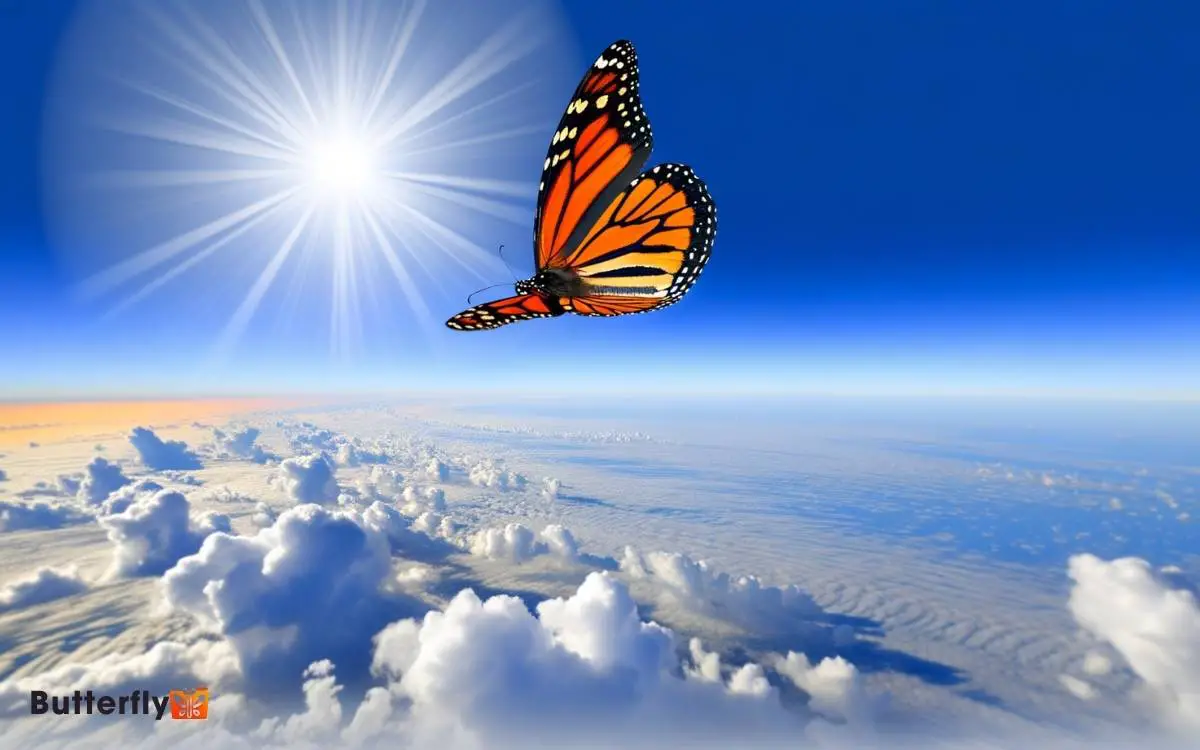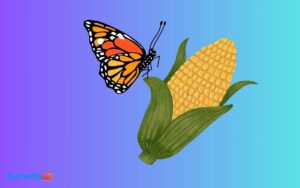How High Can a Monarch Butterfly Fly? High As 11
You’d be astonished to know that monarch butterflies, or Danaus plexippus, can fly as high as 11,000 feet. Their unique wing structure and rapid muscle contractions enable these feats.
They utilize thermal updrafts and wind currents to conserve energy and elevate their flight. Field reports and radar technology confirm these impressive altitudes, often reached during their migration between North America and central Mexico.
Factors like temperature and atmospheric pressure also play vital roles. By observing their migratory patterns and environmental adaptations, you’ll uncover the full marvels of their high-altitude journeys.

Key Takeaways
Monarch Butterfly Flight Basics
Monarch butterflies, known scientifically as Danaus plexippus, possess specialized flight muscles and lightweight wing structures that enable their remarkable aerial capabilities.
You’ll find that their wings are made of chitin, a strong, lightweight material, allowing them to glide effortlessly.
Their flight muscles, primarily the dorsoventral and dorsolongitudinal muscles, contract rapidly, giving them the power to flap their wings up to 12 times per second.
These butterflies also use thermoregulation, relying on solar radiation to warm their wing muscles to the ideal temperature range of 82-102°F. This enables sustained flight.
Field studies have shown that monarchs utilize a combination of flapping and gliding techniques, conserving energy during long migrations. Observing these adaptations highlights their evolutionary success in traversing vast distances.
Peak Flight Altitudes
You’ll find that monarch butterflies have been recorded at altitudes as high as 11,000 feet. Environmental factors such as wind currents, temperature, and atmospheric pressure greatly influence these peak flight heights.
Recorded Flight Heights
Researchers have documented that monarch butterflies can reach altitudes as high as 11,000 feet during their migratory flights.
This astounding flight height has been recorded through a blend of observational studies and technological aids like radar and GPS tracking.
Here are some key findings:
- Radar Observations: Scientists have utilized radar technology to track monarchs at altitudes up to 11,000 feet, validating these incredible heights.
- GPS Tagging: GPS-tagged monarchs provide precise data, showing frequent altitudes between 1,500 and 3,000 feet, with occasional peaks.
- Field Reports: Field observations from researchers and citizen scientists report monarchs flying above 7,000 feet, especially in mountainous regions.
These findings underscore the monarch’s remarkable adaptability and endurance during migration.
Influencing Environmental Factors
Environmental factors, such as wind patterns, temperature gradients, and atmospheric pressure, greatly influence the peak altitudes at which monarch butterflies fly during migration.
You’ll notice that favorable tailwinds can elevate flight altitudes, assisting the butterflies in conserving energy.
Temperature gradients also play a significant role; warmer air masses allow for higher thermal currents, enabling monarchs to reach greater heights.
Atmospheric pressure variations affect the density of the air, impacting the lift monarchs can achieve.
Studies show that during high-pressure systems, monarchs often fly at lower altitudes due to denser air providing better lift. Conversely, low-pressure systems can enable them to ascend higher.
Understanding these factors helps explain the dynamic flight patterns observed in monarch migrations.
Migration Patterns
Monarch butterflies begin one of nature’s most remarkable migration patterns, journeying up to 3,000 miles from North America to central Mexico. This migration isn’t a single generational event but involves several generations.
You’ll see that their journey relies on:
- Environmental Cues: Monarchs use the position of the sun and the Earth’s magnetic field to navigate.
- Rest Stops: They require milkweed for laying eggs and nectar plants for sustenance.
- Altitude Adaptation: Monarchs can alter their flight altitude to take advantage of favorable wind currents, sometimes reaching heights of 10,000 feet.
Detailed observations reveal that these butterflies exhibit an innate ability to follow specific migratory routes, a concept supported by scientific studies. Their journey is a demonstration of the complex interplay between biology and the environment.
Flight Mechanics
When examining the flight mechanics of monarch butterflies, you’ll find that their unique wing structure and muscle arrangement allow for efficient and sustained long-distance travel.
Their wings are composed of a lightweight, yet robust network of veins and membranes, providing both flexibility and strength. This design enables lift and maneuverability.
Monarchs possess two sets of flight muscles: direct and indirect. Direct muscles attach directly to the wings, facilitating precise movements, while indirect muscles deform the thorax, creating a more powerful stroke.
Studies show that monarchs can glide by exploiting thermal updrafts, conserving energy over extensive migratory routes. Their flight speed averages around 12 mph, with bursts up to 20 mph.
These adaptations are essential for their endurance during migration.
Environmental Factors
In analyzing the impact of environmental factors on monarch butterfly flight, you’ll find that temperature, wind patterns, and atmospheric pressure play pivotal roles in determining their altitude and migratory success.
These factors collectively influence flight mechanics and energy expenditure.
Let’s break it down:
- Temperature: Monarchs rely on warm temperatures to maintain the muscle activity required for sustained flight. Cooler conditions can limit their ability to ascend.
- Wind Patterns: Favorable wind currents can assist monarchs in reaching higher altitudes with less energy, while adverse winds can impede their progress.
- Atmospheric Pressure: Variations in atmospheric pressure affect air density, which in turn influences lift and drag forces acting on the butterfly, impacting its flight efficiency.
Understanding these factors is essential for comprehending monarch migration dynamics.
Wind and Weather Impact
You might observe that wind speed greatly influences monarch butterfly flight altitude, with stronger winds often aiding in higher ascents.
Weather patterns, particularly thermal updrafts and cold fronts, also play an essential role in their migration efficiency.
Research shows that butterflies utilize these atmospheric conditions to conserve energy and navigate long distances effectively.
Wind Speed Influence
Wind speed greatly influences the flight altitude of monarch butterflies, often determining their migration patterns and energy expenditure.
When wind speeds are favorable, monarchs can ascend to higher altitudes, allowing them to glide and conserve energy. Conversely, strong headwinds force them to fly lower, increasing energy expenditure and potentially altering migration routes.
Three key observations highlight wind speed’s impact:
- Critical Wind Speeds: Monarchs prefer moderate tailwinds to assist their long-distance travel, reducing metabolic costs.
- Headwind Challenges: Strong headwinds can greatly hinder progress, causing butterflies to seek lower altitudes or delay migration.
- Energy Conservation: Favorable winds at higher altitudes enable monarchs to conserve energy by gliding, thereby prolonging their flight endurance.
Understanding these dynamics is essential for comprehending monarch migration behavior.
Weather Patterns Effect
While wind speed plays a significant role in monarch butterfly flight, broader weather patterns also heavily impact their altitude and migration efficiency.
You’ll find that favorable tailwinds can boost their speed, reducing energy expenditure and allowing higher altitudes. Conversely, headwinds often force monarchs to fly lower and expend more energy.
Temperature variations also matter; cooler temperatures can slow them down, while warmer climates provide ideal conditions for sustained flight.
Research indicates that monarchs prefer clear skies, avoiding heavy rain and storms, which can disorient them and lead to significant energy loss.
Altitude Records
Monarch butterflies have been documented flying at altitudes reaching up to 11,000 feet, according to scientific observations and tracking studies.
This remarkable ability is due to their efficient use of thermal currents and wind patterns. You’ll find that these altitudinal feats aren’t just random occurrences but are part of their migratory strategy.
Here’s what researchers have observed:
- Telemetry Data: Tracking devices attached to monarchs have recorded flights at altitudes exceeding 5,000 feet, with some instances reaching 11,000 feet.
- Radar Observations: Weather radars have detected large groups of monarchs flying at high altitudes during their migratory periods.
- Pilot Reports: Pilots have frequently reported sightings of monarchs at cruising altitudes, providing anecdotal evidence supporting these findings.
These records highlight the monarchs’ extraordinary flight capabilities.
Scientific Studies
Building on these observational records, scientific studies have employed advanced tracking technologies and data analysis to further understand the mechanisms behind monarch butterflies’ high-altitude flights.
Researchers use miniaturized GPS tags and radio telemetry to monitor their migratory paths.
Data reveals that monarchs utilize thermal updrafts to conserve energy during long-distance flights, achieving altitudes over 4,000 feet. High-resolution atmospheric data provides insights into wind patterns and temperature gradients that influence their flight paths.
Computational modeling simulates these migratory behaviors, validating field observations. These studies confirm that monarchs adapt their flight strategies based on environmental conditions, optimizing their energy expenditure and navigation efficiency.
Comparative Analyses
By comparing the flight altitudes of monarch butterflies with those of other migratory insects and birds, researchers can gain deeper insights into the unique adaptations and strategies employed by these remarkable creatures.
Monarchs typically fly at altitudes of 10 to 30 meters, but they can soar up to 1,200 meters when utilizing thermal currents.
In contrast, migratory dragonflies, such as the Globe Skimmer, generally maintain altitudes below 100 meters but can ascend to 1,000 meters. Birds like the Arctic Tern exhibit even more extreme capabilities, flying as high as 2,000 meters during migration.
Key observations include:
- Monarchs’ use of thermal currents for altitude gain.
- Dragonflies’ lower but consistent altitude range.
- Birds’ ability to reach notably higher altitudes.
These comparisons highlight diverse migratory strategies.
Seasonal Variations
Understanding how altitude preferences vary across different migratory species provides a foundation for examining how seasonal shifts impact monarch butterflies’ flight patterns and behaviors.
Monarchs exhibit significant altitudinal variations based on season. During their fall migration, they often fly at higher altitudes, between 1,000 and 2,000 feet, leveraging favorable wind currents.
Spring migrations see them flying lower, closer to 100 feet, to navigate and locate breeding grounds. Environmental factors, such as temperature and wind conditions, influence these altitudinal choices.
For example, cooler temperatures and strong northerly winds encourage higher altitudes, while warmer temperatures and variable winds favor lower flight paths.
Seasonal variations in daylight also play a role, with longer days in spring prompting earlier, lower-altitude flights.
Predators and Threats
You might be surprised to learn that monarch butterflies face numerous threats, including natural predators like birds and spiders.
Habitat destruction due to urbanization and agriculture greatly reduces their breeding and feeding grounds.
Additionally, climate change alters migration patterns and impacts survival rates, presenting a complex challenge for these resilient insects.
Natural Predators Overview
Monarch butterflies face numerous natural predators, including birds, insects, and small mammals, which greatly impact their survival rates.
You’ll find these predators utilizing various strategies to capture and consume monarchs:
- Birds: Species like the black-headed grosbeak and black-backed oriole have developed resistance to the monarch’s toxic cardenolides, allowing them to feed on these butterflies without ill effects.
- Insects: Predatory insects such as wasps and certain beetles target monarch caterpillars and eggs, disrupting the life cycle before they can mature into butterflies.
- Small Mammals: Mice, for example, can consume overwintering monarchs in their clusters, particularly when food sources are scarce.
Understanding these interactions helps you appreciate the delicate balance monarchs maintain to survive in their natural habitats.
Habitat Destruction Impact
Habitat destruction, through deforestation and urban development, greatly exacerbates the threats monarch butterflies face from predators and environmental challenges.
When you remove milkweed and nectar sources, monarchs lose essential resources for feeding and breeding.
Fragmented habitats increase their exposure to predators like birds, spiders, and ants. Furthermore, without dense vegetation, monarchs can’t effectively hide or escape from these threats.
Studies show that monarch populations decline sharply in areas with high deforestation rates. Urban sprawl also introduces pollutants and pesticides, further weakening their resistance to disease.
As habitats shrink, migration paths become perilous, forcing monarchs to fly longer distances with fewer rest stops. You can help by supporting conservation efforts to restore and protect their natural habitats.
Climate Change Effects
How does climate change exacerbate the threats posed by predators to monarch butterflies? Rising temperatures and altered precipitation patterns disrupt the delicate balance of ecosystems.
You’ll notice that monarchs face increased predation as their migratory and breeding cycles are thrown off-sync with their natural predators.
For instance, warmer winters can lead to the earlier emergence of predator species, increasing the vulnerability of monarch larvae and eggs.
- Temperature Changes: Warmer climates accelerate predator life cycles, increasing their numbers.
- Altered Migration Patterns: Disrupted migration can expose monarchs to new predators and less suitable habitats.
- Habitat Shifts: As monarchs seek cooler zones, they may encounter unfamiliar predators and reduced host plant availability.
Understanding these dynamics is crucial for monarch conservation efforts.
Technological Tracking
Thanks to advancements in miniaturized GPS and radio telemetry, researchers can now track monarch butterflies with unprecedented accuracy, shedding light on their high-altitude migration patterns.
By attaching tiny, lightweight transmitters to the butterflies, scientists have observed flight paths reaching altitudes of up to 3,000 meters.
Data collected reveals the butterflies’ ability to navigate wind currents and thermal updrafts, optimizing their energy use during long migrations.
Studies indicate that monarchs use specific altitude zones to avoid predators and adverse weather conditions. Continuous real-time tracking has also provided insights into their stopover sites and resting periods.
This technological leap enables a granular understanding of monarchs’ migratory behavior, essential for developing informed strategies to support their long-distance travel.
Conservation Efforts
Effective conservation efforts for monarch butterflies require a multi-faceted approach that includes habitat restoration, public education, and international cooperation.
You need to focus on creating and maintaining milkweed and nectar-rich habitats, essential for their lifecycle.
Educating the public about the importance of monarchs and how they can help is important. International cooperation guarantees migratory routes are protected across borders.
Consider these key strategies:
- Habitat Restoration: Plant native milkweed species and nectar plants to provide essential resources.
- Public Education: Conduct workshops and distribute educational materials to raise awareness.
- International Cooperation: Collaborate with organizations in Mexico, the U.S., and Canada to protect migratory corridors.
Implementing these strategies can have a significant impact on monarch butterfly populations.
Conclusion
You’ve now seen how monarch butterflies, those delicate marvels of nature, can soar to mind-boggling altitudes sometimes over 10,000 feet! Their epic migrations, spanning thousands of miles, defy imagination.
With cutting-edge technology revealing even more astonishing details, it’s clear these tiny aviators are nothing short of miraculous. Protecting them is paramount; losing such extraordinary flyers would be an ecological tragedy of epic proportions.
So, let’s champion their conservation with unwavering dedication!






